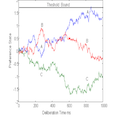Abstract
Animals and humans constantly evaluate and make choices to maximize reward and avoid punishment (value-based decision making). Recently dopamine has been known to play a major role in reward processing, and the cognitive and neural processes of value-based decision making have been widely studied using monkey electrophysiology and human functional magnetic resonance imaging (fMRI). We systematically review the previous findings involved in two critical stages of value-based decision making: valuation and action selection. We describe that human and monkey studies have produced consistent neural substrates for valuing appetitive and aversive events. We show sequential sampling models can be successfully applied to both behavioral and electrophysiological data of action selection, which suggests that they can provide a critical theoretical bridge between neuroscience and behavior.
